Floche is a non-divisible thread, made up of 5 plies of softly twisted cotton. It’s a beautiful thread which stitches up wonderfully. Floche comes in a gorgeous array of colors, though not as many colors are available in the US as there are available in Europe (haven’t the foggiest reason why – ask DMC!).
Floche, as I mentioned, is non-divisible. You’re meant to stitch with the whole strand, not separating it as you would separate stranded cotton.
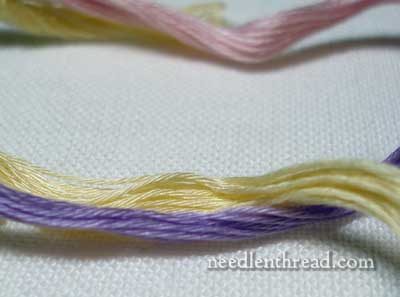
In the photo above, you can see the individual strands of floche in each large bunch of purple and yellow, and in those individual strands, you can see the little plies that twist together to make up the strands.
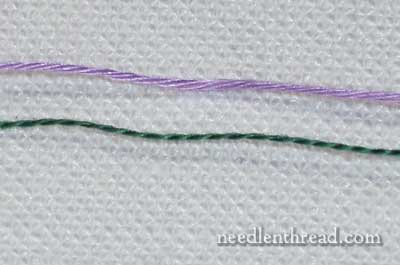
Take one strand of floche (the purple) and one strand of stranded cotton (regular DMC embroidery floss), and you can see that the floche is definitely larger than the stranded cotton floss. In fact, it’s about twice as large – you can use one strand of floche, normally, where you would use two strands of floss.
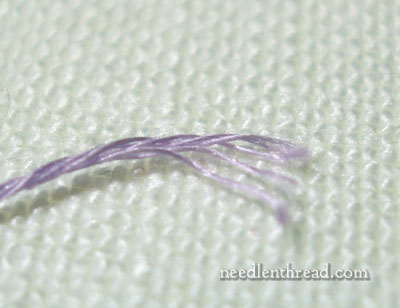
Here, you can see the end of a piece of floche. See all the little tiny plies that work together to make the whole strand?
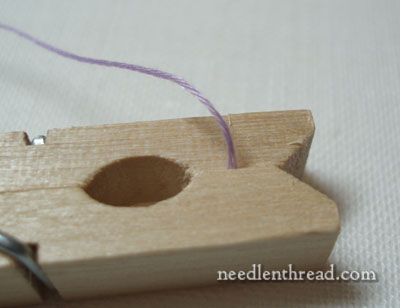
Even though floche is non-divisible – that is, it’s meant to be stitched as is and not separated – that doesn’t mean you can’t separate it. So let’s do that and see what happens!
I’m using a trusty clothes pin, because I want to add a little weight on the bottom of the thread while I separate the plies. You don’t have to do it this way – I just find it easier to get the plies apart if the thread is suspended with a little weight on it.
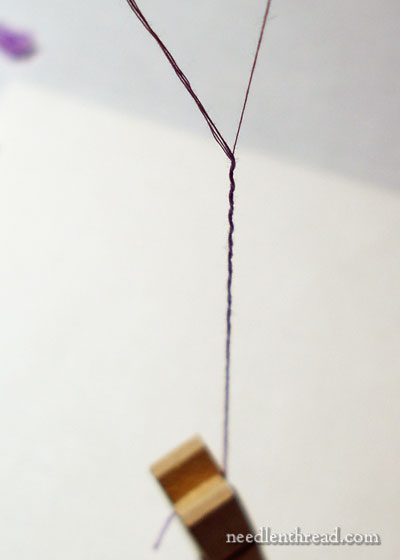
Suspend the thread, with the clothes pin on the end, and pick out a ply. Gently pull the ply away from the rest of the plies, separating it from the bunch. The clothespin with twirl like mad! Separate until you’re close to the clothespin, then pinch the intersection of the single ply and the rest of the thread, and remove the clothespin. The thread will want to come back together, but just ease the single ply out at the very end. It might take a little fiddling, but as long as you pinch the intersection of the single ply and the others, and don’t let them get close to each other again, then it’ll work.
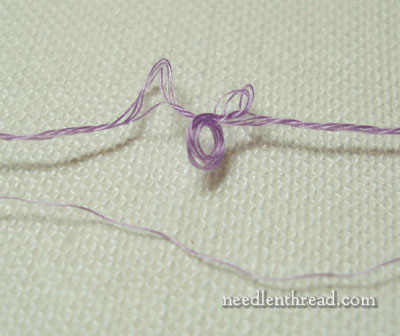
Alternately, you can strip the floche like you do with regular stranded cotton floss, but the little individual plies are kind of weak, so you have to really ease each ply inch by inch, which (as in the photo above) bunches up the rest of the plies and risks knots. The weak individual ply doesn’t withstand heavy tugging well.
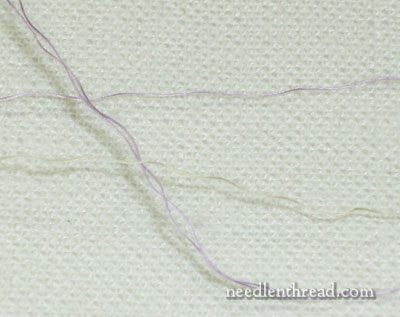
I’ve separated out several plies of yellow and several plies of purple floche here. They’re quite tiny.
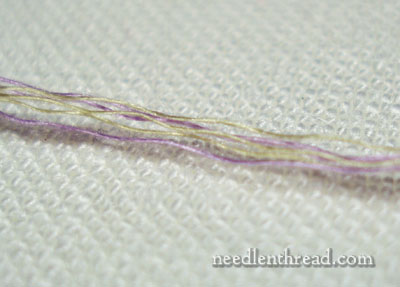
Taking three yellow and three purple, I put them all back into a bunch.
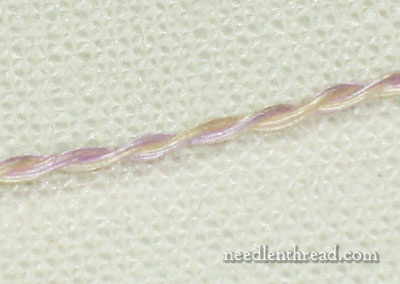
Now, at this point, you can lightly twist the bunch together and come up with a heavier twisted thread. (You don’t have to do this – you can stitch with the loose bunch as is). But if you want to twist them together to make a lightly twisted rope, you do it like this: Tie a knot in the end of your bunch of plies, clamp the knotted end into your clothespin, suspend the clothespin and spin it…. and keep spinning it until you get a good twist on the thread. Then pinch the middle of the thread, and bring the other free end into the clothespin. Again, takes a little fiddling… but once you manage it, the thread will twist together on its own, and you’ll end up with a nice softly twisted thread. This soft of a twist won’t necessarily keep itself as you stitch regular surface embroidery stitches, because, as you pull through the fabric, the twist will loosen up even further. Still, you’ll see two distinct bunches of threads, lightly twisted together, in your stitches.
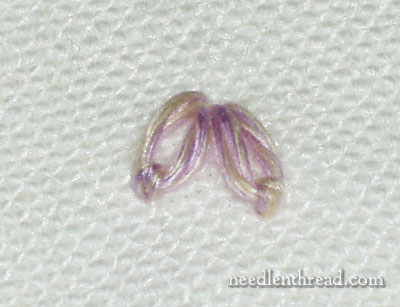
In the left petal there, you can see what I mean by the visible soft twist of the two bunches.
This seems like a fiddly way to work with floche, but you can get some really pretty results separating floche and putting it back together. You can blend colors or just shades of one color, to add a little depth to your stitching. Bullion knots, this way, can look great – they come out very smooth. I’ll see if I can work up some pictures and show you what I mean. In the meantime, you can check out this article on miniature embroidered flowers in buttonhole stitch, if you like. The last photo – with the purple and yellow pansies – make use of this technique of separating floche and putting it back together. (If I still had that piece, I’d take better photos!)
So there’s a little fiddly tip for you – though it requires a bit of extra work, I think the results can be very pretty!







I agree very pretty and delicate.
G’morning, Everyone! Glad you like the tip on separating floche.
Gail, Yep, I find the clothes pin works pretty well, without having to buy yet another tool…. I have clothespins coming out of my ears! The only difficulty is that I only have two hands, but with a bit of fiddling, it works!
Heather – it’s Flosh (long o). I order mine from Hedgehog Handworks (the ad at the end of every blog post lately) – they have the whole range, reasonably priced, and split into smaller skeins so that you don’t have to buy the whole hank. It’s lovely stuff! No, they don’t carry it at craft stores and so forth. I believe it’s imported from France, not part of the standard DMC line in the US. I can’t seem to get a straight answer on that from anywhere, but I’m pretty sure it’s the case.
Enjoy playing with it!
MC
P.S. How do you pronounce it? “flock” (short O sound with hard K) or “Flosh”(long O sound with soft “sh”). Also is it sold in dept store type places with regular DMC, like Joann’s?
How I wish I could take a shopping trip with you to a hobby lobby. *sigh*
This is a great idea! I use Floche for shadow embroidery, but I never thought of separating it when I do other type of embroidery.
I love the way it looks and will try it.
Thanks for the tip.
Sweet! I’ve combined the cotton floss strands while stitching, but never heard of doing this with floche. And I like the clothes pin – I’ve seen the pricey “floss separators” which are basically a weight, a swivel hook, and a clip.
I love the color combination, it’s a nice alternative to varigated threads.
I knew you could separate the plies, but I never thought of putting different colors together once the plies were separated. Duh! What a great, creative idea!
Thanks, Mary. I really love the look of the flosh “remixed”. I don’t think I would have thought of it on my own. I also like that clothespin trick. I can use that one on a number of threads.
Linda Taylor
This reminds me of a class lesson where we separated perle coton. We didn’t recombine it; we used the single ply. It gave a beautiful impersonation of flat silk with a lovely sheen. But, as with the floche, it weakens the thread.
Dear Marymentor:
Thanks so much for this one. I often wondered why my finished stitches looked so bumpy and irregular. I mean “THIS” is BASIC !
Think Spring….well….I”m trying ! 🙂
Judy in Pittsburgh
PS> I Also see the value in the straightening/flattening tool here 🙂
Grazie, molto interessante, ma non ci penso proprio a fare tutto questo lavoro per pochi punti….io allora non sono una vera ricamatrice!
Bacioni, al prossimo post!
I think floche used to come in different sizes. Today it is usually only in 1 size (16, I think). When I first got Lady Evelyn’s book, in order to even try to duplicate her 1-inch square unicorn (yeah, right!..), the only way to get thread small enough was to divide floche. But the shredding was very problematic. Thanks for the tutorial and ideas.
As a spinner, I might be able to assist a bit here.
If you use a ROUND clothespin (good luck finding one LOL) or similar (tying the end to the end of a tiny wooden dowel or even a wood-handled q-tip), you can hold one end of the thread and roll the pin along your leg if you want a touch more tightness in your twist.
The more twist you put into your separate plies as you wind them together, the firmer the resulting thread when it is allowed to ply back on itself. You want it to be twisted a bit more than your final vision for the thread.
To do this part, I cheat: I hold both ends of the slightly-overtwisted strand and grab the middle of it with my lips. Hold while bringing both ends together directly in front of you, pinch, then let go of the middle slowly. The strand will twist right on up.
I can send Mary pictures if need be–it’s a neat trick and I use it often to blend strands of DMC for color variants and to make ‘sampler’ yarn snatches from various fibers.
Hi, Pam! I use my teeth, too. I didn’t really want to mention that. 🙂 (That’s the fiddly part!) I couldn’t find round clothes pins that clamped. They all just have that split in the middle. So I end up using the square ones, and they actually work pretty well. I use the same method for making twisted cording for finishing work – and in fact, sometimes, if I need to make a long length of twisted cord, I use a drill and insert a round closed “hook” in the bit area, and tie the thread onto it. Just beats using something like a pencil and standing there twisting for 10 forevers. I’ll blog about it some day – next time I have the mess out! Thanks for the tips!!
Any idea for a substitute for a round clothes pin? (Besides a square one?) Something round that clamps would be ideal…
Hi, Bobbi! The shredding is problematic. I notice it doesn’t happen as much, if the threads are put back together like this, but to stitch with a single ply of floche, I had to use a really short strand, and even then, I had to end it and start a new one before too long. By short, I’m talking about 9″ or less, and I probably cut 2″ off that when I ended it. I’m wondering if a different sized needle – slightly larger than I would use for that size of thread – might help a little bit. Hmmm…..
Thanks for your comments, everyone! Enjoy the weekend!
MC
Just beautiful. The purple and yellow together looks like Easter eggs. Very pretty.
I’m a day late and a dollar short as the saying goes but would it be easier to separate the strands if they were lightly steamed first? A friend told me about that technique with EdMar which has a distinct twist to it. Once it’s steamed, it lays out so smooth and straight. Then again, maybe that only works with rayon threads, not cotton.
Hadn’t thought about that, Irene. I have a feeling the dampness on the cotton would make it more difficult to separate. But next time I’m playing with floche, I will certainly try it! After separating, I could see lightly steaming to remove the kinks, but it’s not that bad – once you put them back together, they stitch up nice and smooth. But I’ll play with it next time and see what happens! Thanks! MC
Hi, I am finding a lot of project using DMC floche, but it impossible to purchase in the uk. Why do DMC not have it available in the uk. I have used DMC perle 25 in blanc,but some projects are now using colours.
Inspirations magazine use it a lot, so what are the alternatives, please can you help..?
.
Margaret
Any idea where one can find floche in UK? DMC only sells it in white here and I haven’t got the foggiest where to find more…